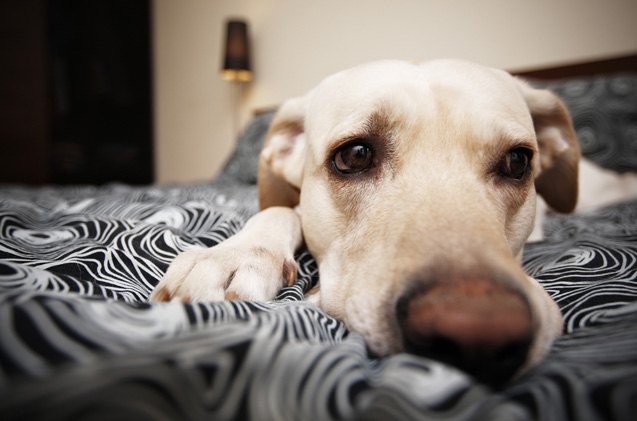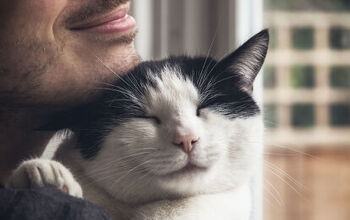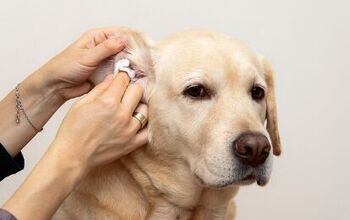5 Stress-Free Ways To Deal With Dog Separation Anxiety

Dog separation anxiety is a common condition in canines. It affects dogs of all ages and breeds and can cause serious distress and injury to your pooch. It’s our job as pet parents and owners to make sure they are comfortable and at ease when we can’t be with them. Let’s go over some of the common causes and symptoms of dog separation anxiety before we tackle the tips.
There’s no concrete evidence that can tell us exactly why dogs develop separation anxiety. But there are a series of common situations that can lead to dog separation anxiety. Some dogs are just anxious by nature (born with it), are taken away from their mothers too soon as others, or develop it because of a dramatic life event (being left by their family at a shelter). Here are a few common reasons why it may happen to your dog:
Boredom: Left alone for hours on end with nothing to do… it’s not a surprise that your dog has separation anxiety.
Change in routine: If you’re changing jobs (especially if you’ve typically been at home) or have a demanding schedule that leaves your dog alone for long periods of time, your dog may start to exhibit signs of separation anxiety.
Moving to a new house: Dogs thrive on routine, and moving to a new home can have a big impact on his daily routine. There are new sights, sounds, and smells to content with, and nothing looks familiar anymore. He hasn’t established his own special place in the house and he doesn’t know where to go. This can cause a lot of anxiety.
Change of family members: A child going away to school or a death in the family can be stressful on a dog. This can bring out separation anxiety issues.
Change of family: When a dog is given up to a shelter or given to a new family, it’s a situation that can stir up separation anxiety. And it’s no wonder – this is a very traumatic event in a dog’s life.
If your dog suffers from Separation Anxiety, you can expect any of the following symptoms to occur:
- Chewing and destroying household objects
- Digging at doors or fences
- Persistent barking and howling
- Urinating and defecating in the house
- Coprophagia (when a dog eats all or some of his excrement)
- Trying to escape from a confined area (digging and chewing at doors and window frames)
- Pacing in a circular motion or in straight lines
These tips are meant for dogs with mild to moderate separation anxiety issues. If your dog suffers from severe separation anxiety, please talk to your veterinarian (there may be medical reasons behind the symptoms or he/she can prescribe a course of medication or treatment) or a professional dog trainer who specializes in this form of anxiety disorder.
Plenty of exercise: A vigorous walk or job every morning before you leave for the day can not only give your dog some extra time with you, but will also help tire him out. Even a romp to the dog park will give him the activity he needs. This can last anywhere from 30 minutes to an hour. By the time you’re ready to leave, he’ll be calmer and ready for a morning nap.
Start small: This step is important for all ages of dogs coming into your home: from puppy to adults. Start by leaving your dog alone for short periods of time. Leave your home for 10 minutes (you may want to stay in ear shot to hear if your dog barks or whines for the time you’re away from him, but make sure he can’t see you). Once you know your dog is comfortable with you being gone for short amounts of time, start stretching it out to 20 minutes, 30 minutes, 45 minutes, and so on. There’s no set schedule as to how long it will take for your dog to get used to your absence – every dog is an individual, so results will vary. If you’re working for a full day, you want to be sure that your dog can be comfortable without you for eight hours.
Dog walker or daycare: Doggy daycares are popping up all over the place. This is because working pet parents want their dogs to have company while they are away from home. Dogs get to play with other pooches, get taken out for walks and some even provide field trips. If you can’t afford a doggy day care, there are dog walkers who will pop by your house to take your dog out for a walk and bathroom break. This may be enough companionship and a much-needed break in the day that will tide your dog over until he gets to see you again.
Exits and entrances are no big deal: If you act like leaving is no big deal, chances are your dog will think so too. Don’t make any eye contact or a fuss when you leave for the day. Same thing goes when you come home – no huge hugs or belly rubs. Wait about five minutes. Put your stuff down, take care of a couple of errands (opening mailing, putting stuff away). Only then can you greet your dog with a happy hello and head scratch.
Treat ball: This is one trick I use daily. I stuff a ball will treats that Oscar needs to play with for about 20 minutes in order to shake them free. He knows and looks forward to when I leave in the morning, as he sits by the stairs, waiting for my signal to go get it. By the time he’s done, he forgets that I’ve left. Along with a treat ball, leave lots of toys and activities for your dog to amuse himself with.
There are many different reasons why a dog may have separation anxiety and things you can do about it. If your dog suffers from separation anxiety, what do you do to make him feel better and more secure when he’s at home alone? Please leave your comments and suggestions in the comment section below.

Amy Tokic, Editor of PetGuide.com, is a passionate animal lover and proud pet parent of Oscar, a Shih Tzu/Chihuahua cross, and Zed, a Japanese Chin. Her love of animals began in kindergarten, when she brought her stuffed dog Snoopy into class with her every day. Now, she writes about her adventures in pet ownership and tirelessly researches products, news and health related issues she can share with other animal enthusiasts. In her free time, Amy loves perusing used book and record stores, obsessing over the latest pet products available and chasing squirrels with wild abandon (a habit attributed to spending too much time with her pooches).
More by Amy Tokic























